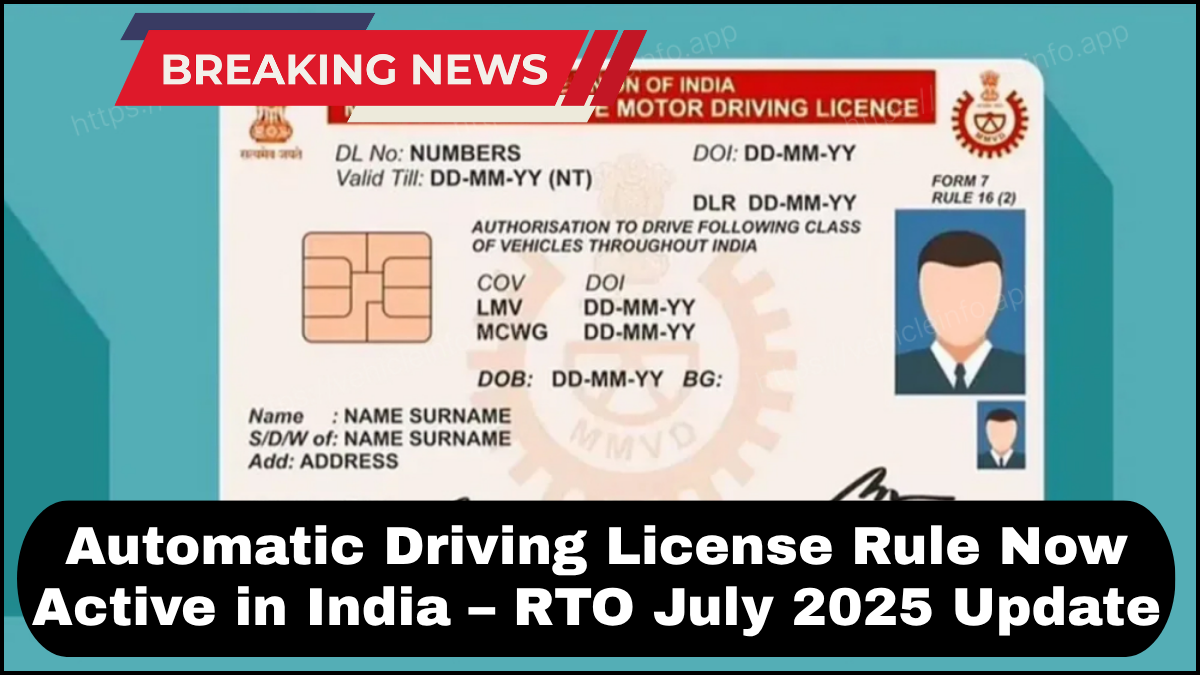The Ministry of Road Transport and Highways (MoRTH) has officially implemented a major update to the driving license process in India as of July 2025. With the rollout of the Automatic Driving License rule, the traditional method of visiting an RTO for a driving test is no longer mandatory for many applicants. This regulatory shift under the RTO License India 2025 framework is aimed at making the process more efficient, transparent, and tech-driven.

What Is the Automatic Driving License Rule?
The Automatic Driving License rule allows eligible candidates to obtain a driving license without appearing for a physical driving test at a Regional Transport Office (RTO). Instead, driving tests can now be conducted at authorized private training centers equipped with automated testing tracks.
Once a candidate passes the test at one of these certified centers, the results are digitally transmitted to the RTO, and the license is issued automatically—removing human bias and administrative delays from the process.
Why Was This Rule Introduced?
The Indian government introduced this rule to reduce corruption, improve road safety, and eliminate inefficiencies in the traditional RTO licensing system. Key drivers for this change include:
-
Reducing RTO congestion: The new rule will significantly cut down the footfall at RTOs, easing the workload on government staff.
-
Eliminating manual errors: Automated tracks ensure test results are objective and consistent, reducing the chance of human error or influence.
-
Increasing transparency: With automated systems, every part of the test is recorded and tracked, ensuring fairness and accountability.
How Does the New System Work?
Step 1: Enroll in a Recognized Training Center
Applicants must enroll in a driving school approved by the Ministry of Road Transport. These centers are equipped with state-of-the-art facilities, including sensor-based tracks and real-time monitoring systems.
Step 2: Complete Training and Internal Assessment
Candidates undergo structured training under the supervision of certified instructors. Once training is complete, an internal test is conducted on automated tracks that monitor key metrics such as:
-
Vehicle control
-
Lane discipline
-
Speed management
-
Braking and turning accuracy
Step 3: Data Submission to RTO
Once the candidate clears the automated test, the center uploads all relevant data—including video evidence and system-generated scores—directly to the RTO portal.
Step 4: Automatic License Generation
The RTO system validates the data and issues the Automatic Driving License digitally. There’s no need to appear for a separate RTO test unless discrepancies arise.
Who Is Eligible for an Automatic Driving License?
This facility is currently available for:
-
Two-wheeler and light motor vehicle (LMV) license applicants
-
Applicants above 18 years of age with valid identification and address proof
-
Candidates who successfully complete training at a government-approved automated testing center
Note: Commercial vehicle licenses still require an in-person RTO test until further updates are announced.
Impact on the RTO Licensing Ecosystem
The RTO License India 2025 update marks a significant leap toward digital governance in the transport sector. Over 1,000 automated centers are expected to be operational across India by the end of 2025. These changes are expected to:
-
Boost confidence in the licensing system
-
Reduce license-related fraud
-
Enhance driver preparedness through better training
States like Maharashtra, Karnataka, and Delhi have already reported smoother operations and increased satisfaction among applicants using the new system.
Advantages of the Automatic Driving License System
-
Time-saving: Applicants no longer need to schedule appointments or wait in long queues.
-
Cost-effective: Reduces the need for intermediaries or agents.
-
Fair assessment: Sensors and cameras provide unbiased results.
-
Environmental benefit: Digital processes reduce paperwork and manual filings.
Limitations and Areas of Improvement
While the system promises a streamlined approach, challenges remain:
-
Availability of automated centers in rural areas is limited
-
Initial training costs at private centers may be higher than government alternatives
-
Digital literacy is a barrier for some applicants
However, the government is working to address these gaps by offering subsidies, increasing public awareness, and scaling up training infrastructure.
FAQs
1. What is the Automatic Driving License rule in India?
The Automatic Driving License rule allows candidates to obtain a license without appearing for an RTO test, provided they pass the driving test at a certified automated training center.
2. Is the traditional RTO driving test still available?
Yes, the traditional test is still available for those who choose not to go through a private center or in areas where automated centers are not yet operational.
3. Does this apply to commercial licenses?
Not yet. As of July 2025, the rule only applies to private vehicle licenses like two-wheelers and LMVs.
4. How can I find an approved automated training center?
You can check the official MoRTH or Parivahan portal for a list of certified training institutes in your region.
5. Is the automatic driving license valid across India?
Yes, once issued, the license is valid throughout the country just like a regular RTO-issued license.
click here to learn more